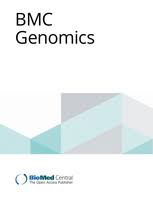Ver ítem
- xmlui.general.dspace_homeCentros e Institutos de InvestigaciónCIRN. Centro de Investigaciones de Recursos NaturalesInstituto de Recursos BiológicosArtículos científicosxmlui.ArtifactBrowser.ItemViewer.trail
- Inicio
- Centros e Institutos de Investigación
- CIRN. Centro de Investigaciones de Recursos Naturales
- Instituto de Recursos Biológicos
- Artículos científicos
- Ver ítem
Characterization of the repetitive DNA landscape in wheat homeologous group 4 chromosomes
Resumen
Background:
The number and complexity of repetitive elements varies between species, being in general most represented in those with larger genomes. Combining the flow-sorted chromosome arms approach to genome analysis with second generation DNA sequencing technologies provides a unique opportunity to study the repetitive portion of each chromosome, enabling comparisons among them. Additionally, different sequencing approaches may produce different depth
[ver mas...]
Background:
The number and complexity of repetitive elements varies between species, being in general most represented in those with larger genomes. Combining the flow-sorted chromosome arms approach to genome analysis with second generation DNA sequencing technologies provides a unique opportunity to study the repetitive portion of each chromosome, enabling comparisons among them. Additionally, different sequencing approaches may produce different depth of insight to repeatome content and structure. In this work we analyze and characterize the repetitive sequences of Triticum aestivum cv. Chinese Spring homeologous group 4 chromosome arms, obtained through Roche 454 and Illumina sequencing technologies, hereinafter marked by subscripts 454 and I, respectively. Repetitive sequences were identified with the RepeatMasker software using the interspersed repeat database mips-REdat_v9.0p. The input sequences consisted of our 4DS454 and 4DL454 scaffolds and 4ASI, 4ALI, 4BSI, 4BLI, 4DSI and 4DLI contigs, downloaded from the International Wheat Genome Sequencing Consortium (IWGSC).
Results: Repetitive sequences content varied from 55% to 63% for all chromosome arm assemblies except for 4DLI, in which the repeat content was 38%. Transposable elements, small RNA, satellites, simple repeats and low complexity sequences were analyzed. SSR frequency was found one per 24 to 27 kb for all chromosome assemblies except 4DLI, where it was three times higher. Dinucleotides and trinucleotides were the most abundant SSR repeat units. (GA)n/(TC)n was the most abundant SSR except for 4DLI where the most frequently identified SSR was (CCG/CGG)n. Retrotransposons followed by DNA transposons were the most highly represented sequence repeats, mainly composed of CACTA/En-Spm and Gypsy superfamilies, respectively. This whole chromosome sequence analysis allowed identification of three new LTR retrotransposon families belonging to the Copia superfamily, one belonging to the Gypsy superfamily and two TRIM retrotransposon families. Their physical distribution in wheat genome was analyzed by fluorescent in situ hybridization (FISH) and one of them, the Carmen retrotransposon, was found specific for centromeric regions of all wheat chromosomes.
Conclusion: The presented work is the first deep report of wheat repetitive sequences analyzed at the chromosome arm level, revealing the first insight into the repeatome of T. aestivum chromosomes of homeologous group 4.
[Cerrar]

Autor
Garbus, Ingrid;
Romero, José Rodolfo;
Miroslav, Valarik;
Vanzurova, Hana;
Karafiatova, Miroslava;
Caccamo, Mario;
Dolezel, Jaroslav;
Tranquilli, Gabriela;
Helguera, Marcelo;
Echenique, Carmen Viviana;
Fuente
BMC Genomics 16 (375) : 1-16. (2015)
Fecha
2015
ISSN
1471-2164
Formato
pdf
Tipo de documento
artículo
Palabras Claves
Derechos de acceso
Abierto
 Excepto donde se diga explicitamente, este item se publica bajo la siguiente descripción: Creative Commons Attribution-NonCommercial-ShareAlike 2.5 Unported (CC BY-NC-SA 2.5)
Excepto donde se diga explicitamente, este item se publica bajo la siguiente descripción: Creative Commons Attribution-NonCommercial-ShareAlike 2.5 Unported (CC BY-NC-SA 2.5)


